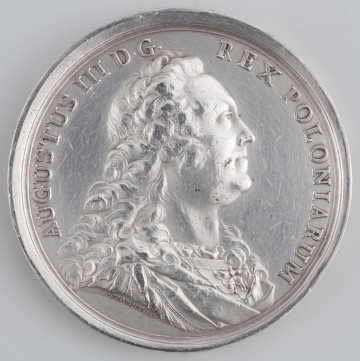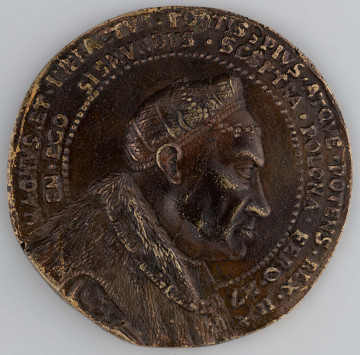
For the feast of the Order of the White Eagle
1760
National Museum in Lublin
Part of the collection: Polish medallic art.
One of the rulers most interested in, or even fascinated by, medal-making was undoubtedly Sigismund III Vasa. This king, a follower of new trends in art, was known as a generous patron. It is also known that he himself tried his hand at goldsmithing and medal-making. Written sources inform us that he used to give medals, which he himself made, to selected people from his circle. No works of the monarch have been preserved, but they are mentioned in the sources of the epoch. The royal passion influenced people from the monarch’s surroundings. In the times of Sigismund III Vasa, the number of people immortalized on medals increased significantly. Also the fashion for collecting this type of objects became more and more popular. The most prominent representative of Polish medal-making of that time was undoubtedly Samuel Ammon, who spent his entire artistic life in Gdańsk. Not surprisingly, the medal presented here was also attributed to Samuel Ammon due to its artistic qualities. Unfortunately, there are no indications to that effect. In fact, it was most probably made by a talented but unfortunately unknown medallist in Austria or Bohemia. The medal commemorates the conquest and annexation of Smoleńsk to the Polish-Lithuanian Commonwealth in 1611. In this way, it refers to the tradition of commemorating great historical events, which had begun earlier. Undoubtedly, the significance of the Smoleńsk victory, achieved after almost two years of siege, made the medal created for this occasion exceptionally impressive. The only known original copy was cast in gold, weighing 315 ducats at the time, which corresponds to slightly more than 1 kg of precious metal. It is currently exhibited in the Kunsthistorisches Museum in Vienna. The obverse of the medal contains a depiction of the victorious ruler, typical of the period. The reverse was probably based on an unknown image. It depicts the climax of the siege, i.e. the scene of the capture of the city.
The presented copy of the medal was made in iron using the casting method. Like other later copies it differs slightly in dimensions from the original. The use of iron as a casting material resulted in a slight deterioration of the rendering of the details, which are slightly less legible than in the case of the original or other copies.
Leszek Poniewozik
Author / creator
Dimensions
cały obiekt: width: 128 mm
Object type
medal
Technique
cast
Material
iron
Creation time / dating
Creation / finding place
Owner
The National Museum in Lublin
Identification number
Location / status

1760
National Museum in Lublin

1840 — 1860
National Museum in Lublin

National Museum in Lublin
DISCOVER this TOPIC
Museum of King Jan III's Palace at Wilanów
DISCOVER this PATH
Educational path